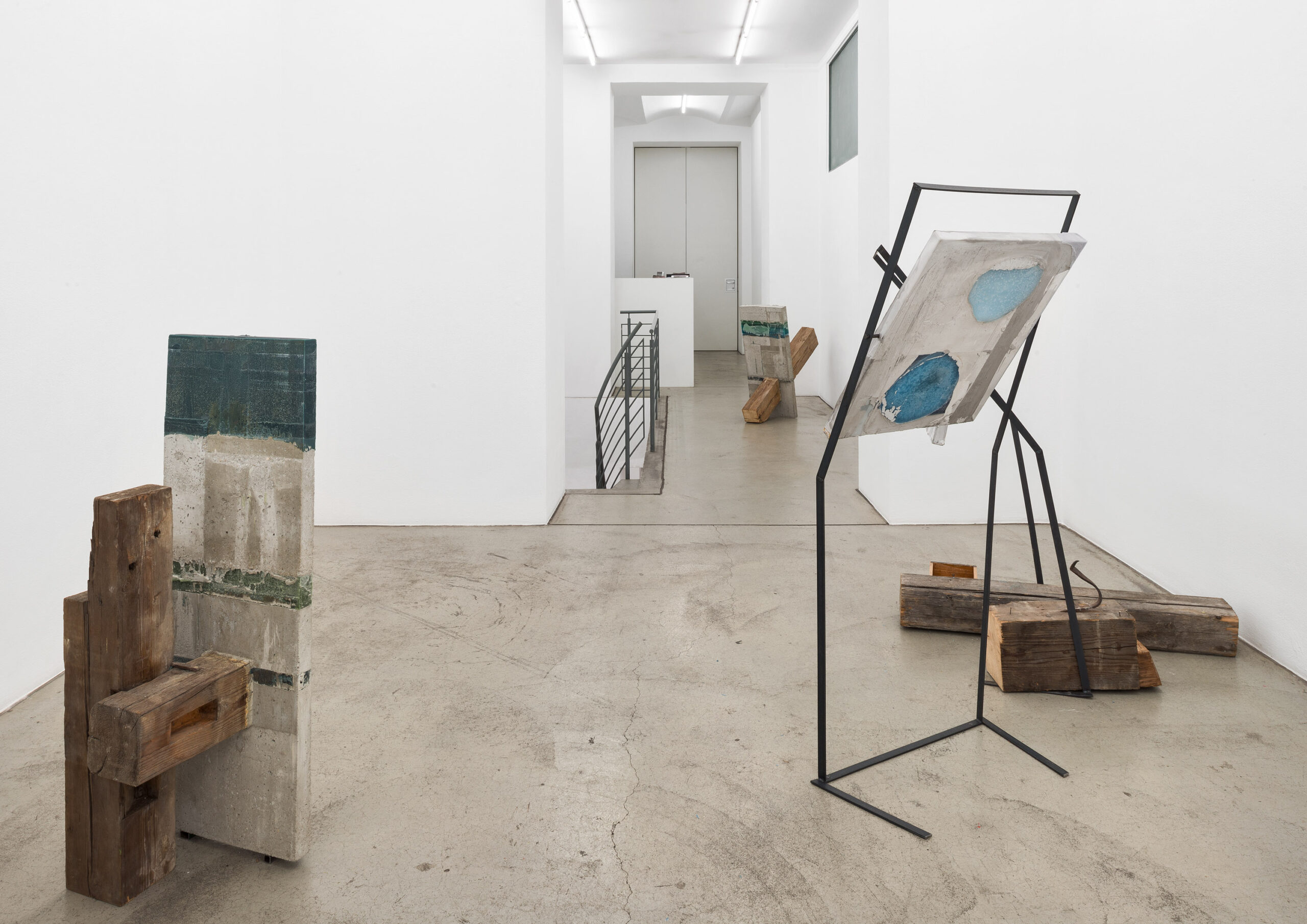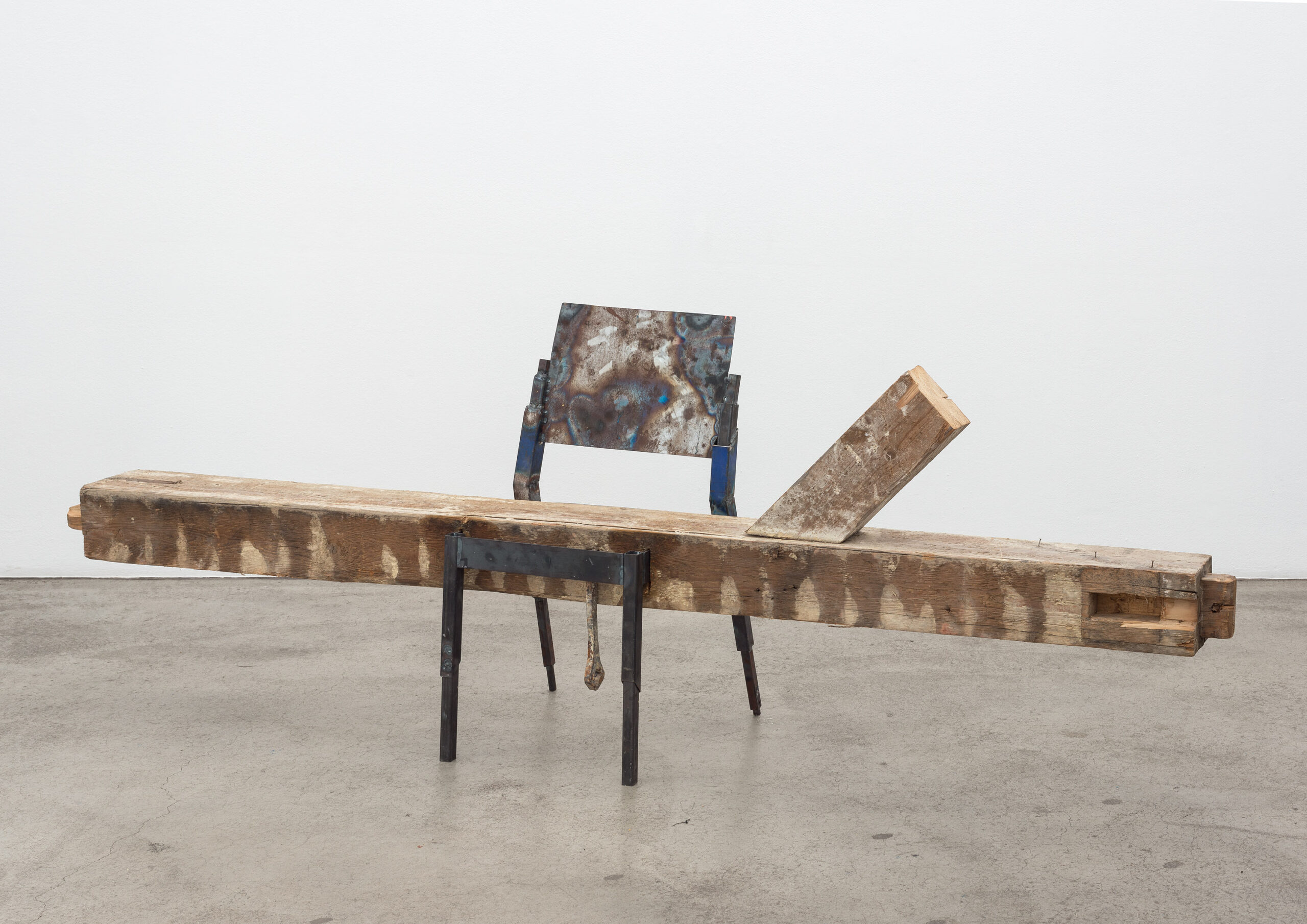
Dachbalken aus Abrisshäusern sind das Ausgangsmaterial für Cäcilia Browns Ausstellung in der Gabriele Senn Galerie. Die Wiener Stadtregierung reagierte im Sommer mit einer vorgezogenen Novelle der Bauordnung auf die bereits seit geraumer Zeit andauernde Abrisswelle, der jährlich rund 150 historische Bauten zum Opfer fielen. Seit Juli dieses Jahres müssen für Abrisse von Gründerzeitbauten Genehmigungen eingeholt werden, was in den letzten Monaten vor Ende dieser Regelung nochmals zu einer stärkeren Abrisstätigkeit führte. Häufig sind auch nur die Dachböden betroffen, die für den Ausbau von Luxuswohnungen –Brown nennt sie „Wohlstandsdeckel“– abgerissen werden. Die maximale Ausnutzung von Stadtraum setzt sich, nachdem am Boden inzwischen fast lückenlos bebaut wird, nun auch in der Vertikalen fort und lässt Leerräume allmählich verschwinden.
Diese sozioökonomischen Aspekte formuliert Brown in ihrer Arbeit nicht in einer explizit politischen (wenn auch politisch motivierten), sondern in einer skulpturalen Sprache, die Eigenschaften und Eigenheiten des aus den zerstörten Häusern geborgenen Materials –das hier gewissermaßen wie Archivmaterial behandelt wird– beschreibt und hervorhebt. So wird etwa die Sitzfläche einer groben Kopie des Contract Chairs von Karl Schwanzer ersetzt durch einen massiven, mit Taubendreck verkrusteten Balken, dessen extreme Länge das verhältnismäßig recht zierliche Möbelstück offensichtlich überfordert.
„Wer auf der Unnachgiebigkeit der Stoffe besteht, lässt nicht zu, dass ihre Objektivationen sich anbiedern.“ schrieb der Kunsthistoriker Wolfgang Kemp im Katalog der Ausstellung Holz = Kunst-Stoff (Staatliche Kunsthalle Baden-Baden, 1976).
Die Gefahr, bei der Herkunft und Hintergrundgeschichte des Materials einer gewissen Ruinenromantik zu verfallen ist groß, doch Brown umschifft dies in ihren Arbeiten, indem sie dem Material seine Autonomie belässt und nur minimale Eingriffe vornimmt. Im Wesentlichen beschränken diese sich auf die Kombination von Fragmenten durch anlehnen, auflegen oder stützen, und den Verzicht auf Verschrauben und dauerhaftes Fixieren. Reste von Verzapfungen, Farbflecken und andere Gebrauchsspuren bleiben als Teil der Textur erhalten und nur hin und wieder wird durch das Aufbringen von Wachs ein Detail verstärkt.
Es sind teils „unhaltbare“ Verbindungen, wenn z.B. ein altes Fenster oder eine Tür mit Beton und Wachs ausgegossen wird. Beton als modernes, omnipräsentes Baumaterial steht in den Skulpturen auch für die brachiale Übernahme und Überformung traditioneller architektonischer Konstruktionsweisen. Beim Wachs hingegen interessiert die Künstlerin vor allem dessen Fragilität und Vergänglichkeit – und es ist brennbar, wie die Dachbalken, die häufig in den noch verbliebenen Öfen der Altbauten enden.
Auch ohne eine explizit politische Aussage zu treffen, vermitteln Browns Skulpturen über ihre atmosphärische Dichte und die Weigerung, eine Form zu vollenden und endgültig zu fixieren, einen Hinweis auf die Fragilität des gesellschaftlichen Gefüges: die frischen Schnittstellen in den über hundertjährigen Balkenfragmenten transportieren sie in die glatte postmoderne Gegenwart.
– Bettina Klein

Cäcilia Brown
der Altmieter, 2018
Stahl, Dachbalken
86 x 259 x 48 cm
The basic material for Cäcilia Brown’s exhibition at the Gabriele Senn Gallery are roof beams taken from demolished houses. Following a wave of demolitions, to which approximately 150 historic buildings fell victim to annually, the Viennese government has responded with an amendment to the building code that heralded in these demolitions. As of July of this year, the demolition of traditional Gründerzeit buildings dating from the early twentieth century must first be officially approved. An increased amount of demolitions leading up to the enforcement of this regulation was the result. Often times, only attics are affected, which are demolished for the construction of luxury apartments. Brown calls these the “wealth cap”. To make effective use of as much urban space as possible, construction is now increasingly happening vertically as there is barely ground left to build on. Empty spaces are gradually disappearing.
Brown does not address these socioeconomic aspects in an explicitly political (albeit politically motivated) language, but rather, she communicates in a sculptural language that describes and emphasizes the characteristics and peculiarities of the material recovered from the demolished buildings. In a sense, she treats it as archival material. An example is a rough copy of Karl Schwanzer’s Contract Chair. The sculpture shows a massive beam, encrusted in pigeon droppings, that acts as the chair’s seating surface. It is immediately evident that the beam’s considerable length puts a heavy strain on the relatively delicate piece of furniture.
In the catalogue accompanying the exhibition “Holz = Kunst-Stoff“ (at Staatliche Kunsthalle Baden-Baden, 1976), the art historian Wolfgang Kemp writes, “Those who insist on the intransigence of materials, do not allow their objectifications to ingratiate themselves”.
There’s quite a risk of succumbing to a certain “ruin romanticism” when considering the origin and history of the materials. Brown circumvents this in her work by having the material keep its autonomy and by carrying out only minimal interventions. Her sculptures are basically made up of a combination of fragments that lean on, support or lie on top of each other. This is all done without using screws or other means of permanently fixing the items together. Joints, paint stains and other trace remnants are kept for texture.
Sculptures are partly formed using “unsuitable” joints, e.g. casting an old window or a door with concrete and wax. As a modern building material that is used everywhere, the use of concrete in her sculptures illustrates the forceful takeover and transformation of traditional methods of architectural construction. Wax, on the other hand, is of particular interest to the artist because of its fragility and transience – it is combustible, just like the roof beams that often end up in leftover stoves installed in these turn-of-the-century buildings.
Without necessarily making an explicit political statement, the atmospheric density of Brown’s sculptures and and the refusal to achieve a form and definitely fix it, points towards the fragility of the social fabric. Evidence of fresh cutting marks on old beam fragments transport them into a smooth postmodern present.
– Bettina Klein



